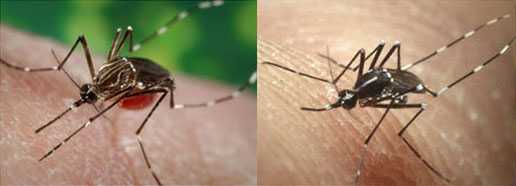Chikungunya: A new mosquito-borne disease hits the Western Hemisphere, including the United States
Health officials at the Centers for Disease Control and Prevention (CDC) and all across the Americas have been tracking the spread of the chikungunya (pronunciation: chik-en-gun-ye) virus since December 2013 when it was first discovered in the Caribbean on Saint Martin. While outbreaks of the virus have previously been reported in some parts of Africa, Europe, Asia and the Pacific, this is the first time the virus has been found among non-travelers in the Western Hemisphere. Chikungunya virus is transmitted to people through mosquito bites. Mosquitoes become infected when they feed on a person with the virus. Infected mosquitoes then spread the virus to other people.
In the last eight months, the virus has sickened over 250,000 people in 22 countries and territories, including 15 cases in the U.S. territories of Puerto Rico and the U.S. Virgin Islands. CDC expects the outbreak to continue this summer throughout Central, Latin and South America. As of July 8 on the United States mainland, 138 cases have been reported from 30 states. To date, all of these cases have been in travelers who were bitten by an infected mosquito while visiting an area where chikungunya is found. These are called “imported” cases. However, as this outbreak spreads and more infected travelers return to the U.S., the risk of local mosquitoes becoming infected increases. There is a high likelihood that the U.S. will experience locally-acquired chikungunya.

Is it chikungunya?
Symptoms of chikungunya typically last about a week and include fever, rash and severe arthritis in one or more joints. For some, however, the pain can last for much longer. There is no vaccine to prevent infection or treatment to cure the disease. For those who are infected, pain is managed with over the counter medications to relieve fever, arthritis and muscle aches.
The virus gets its name from the Makonde language in Tanzania where it was first discovered in 1952. Chikungunya means “that which bends up” because patients suffering with disease are often stooped over in pain while sick. Though infection is rarely fatal, the joint pain can be quite debilitating. People at risk for severe disease include newborns infected around the time of birth, adults age 65 and older, and people with underlying medical conditions such as high blood pressure, diabetes or heart disease. If you develop the symptoms of chikungunya, especially if you have recently traveled to a place where chikungunya is known to be circulating, see your doctor. Diagnosis is made through a blood test.
Don’t let mosquitoes ruin your summer—wear insect repellent
The chikungunya outbreak is occurring in tropical regions of the world where dengue, another mosquito-borne disease, is common. Both chikungunya and dengue viruses are spread by Aedes mosquitoes, which can also be found in many parts of the continental U.S. Aedes mosquitoes can live inside and outside and have adapted to live near people. They are aggressive day-time biters.
When traveling to a country where chikungunya is found, the best way to prevent getting infected with chikungunya is to prevent mosquito bites. Use air conditioning and window and door screens to keep mosquitoes outside. Weekly, empty any standing water from containers like flower pots, buckets, and bowls to reduce the number of adult mosquitoes. When weather permits, wear long-sleeved shirts and long pants to prevent mosquitoes from biting. Use insect repellents. Repellents containing DEET, picaridin, IR3535, or oil of lemon eucalyptus (para-menthane-diol) provide long-lasting protection against biting mosquitoes. Wear insect repellents during the day-time and at night.
Pick your favorite insect repellent and wear it whenever you go outdoors.
For more information on chikungunya: www.cdc.gov/chikungunya
Traveling? Get country specific health information: www.cdc.gov/travel
- Page last reviewed: December 31, 2014
- Page last updated: December 31, 2014
- Content source:
Global Health
Notice: Linking to a non-federal site does not constitute an endorsement by HHS, CDC or any of its employees of the sponsors or the information and products presented on the site.


 ShareCompartir
ShareCompartir